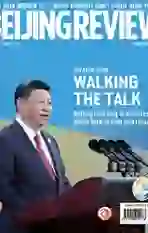Connectivity Counts
2017-06-08
An increase of nearly 1 trillion yuan ($145 billion) in fi nancial support from China. More than 270 outcomes in the five key areas of policy, infrastructure, trade, financial and people-to-people connectivity. A renewed commitment to openness and inclusiveness. These are among the key achievements of the Belt and Road Forum for International Cooperation (BRF), which took place in Beijing from May 14 to 15.
The BRF was a major international event for nations and parties involved in the Belt and Road Initiative to engage in consultation. It also offered a platform for the initiatives participants to strengthen cooperation and synergize development strategies.
The China-proposed Belt and Road Initiative, which aims to forge closer connections along the routes of the ancient Silk Road and beyond, is one of the worlds most influential developments in recent years. Four years on from its initial proposal in 2013, the initiative has gained support from more than 100 countries and international organizations. Resolutions passed by the UN General Assembly and Security Council also contain references to it. The U.S. Government, which once gave a lukewarm response, sent a high-level delegation to the BRF.
Why has the Belt and Road Initiative caught worldwide attention? First of all, having had enough of war over the past centuries, the world longs for lasting peace. While peace and development have featured prominently on the global agenda since the end of the Cold War, the planet has been plagued with sporadic confl icts, battles and terrorist attacks. The Belt and Road Initiative, which centers on the creation of a prosperous and peaceful community with a shared future for mankind, conforms to peoples aspirations.
Moreover, the initiative underlines the need for countries to align their development strategies so that their comparative strengths can be exploited to the full. In pursuing the Belt and Road Initiative, China will not resort to outdated geopolitical maneuvering, nor does it intend to form a small clique. Instead, it hopes to achieve a new model characterized by extensive consultation, joint contribution and shared benefi ts.
In addition, the economic growth model dominated by the West is wavering, giving rise to trade protectionism and doubts about globalization. In this context, an innovative vision is crucial to power global development. The Belt and Road Initiative, drawing on the spirit of the ancient Silk Road, calls for making economic globalization benefi cial to all.
The ancient silk routes have retained their significance right up to the present day largely because they connected different cultures. The pioneers did not conquer others with warships, guns or swords; rather, they were friendly emissaries leading camel caravans and sailing treasure-loaded ships. Today, the Belt and Road Initiative presents opportunities to build new bridges of cooperation.
